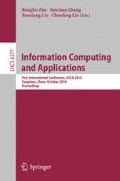Abstract
As the rapid growth of personal credit business, we have always been seeking to establish an effective risk assessment model to achieve low costs and better accuracy of decision-making. Over the past few years, the so-called combined algorithms have appeared in many fields, but they are always useless in the field of individual credit risk assessment. So we constructed a practical method based on combined algorithms, and we tested it empirically. The result shows that the application of the method can achieve better accuracy than the BP neural network.
Access this chapter
Tax calculation will be finalised at checkout
Purchases are for personal use only
Preview
Unable to display preview. Download preview PDF.
References
Xiangyang, X., Jike, G.: Research on Personal Credit Scoring Model based on Clustering. Financial Electronics 9, 229–231 (2006)
Kittler, J., Hatef, M., Duin, R.P.W., Matas, J.: On combining classifiers. IEEE Transaction on Pattern Analysis and Machine Intelligence 20, 226–239 (1998)
Breiman, L.: Bagging predictors. Machine Learning 26, 123–140 (1996)
Bauer, E., Kohavi, R.: An empirical comparison of voting classification algorithms: Bagging, boosting and variants. Machine Learning 36, 105–139 (1999)
Schapire, R.: The strength of weak learns ability. Machine Learning 5, 197–227 (1990)
Drucker, H., Cortes, C., Jackel, L.D., Lecun, Y., Vapkin, V.: Boosting and other ensemble methods. Neural Computation 6, 1289–1301 (1994)
Freund, Y., Schapire, R.: A decision theoretic generalization of on-line learning and an application to boosting. Journal of Computing and Systems 55, 119–139 (1996)
Wolpert, D.: Stacked generalization. Neural Networks 5, 241–259 (1992)
Twala, B.: Multiple classifier application to credit risk assessment. Expert Systems with Applications 37, 3326–3336 (2010)
Jiuqing, H.: System Engineering. China Statistical Publishing House, Beijing (1999)
Yuanzheng, W., Yajing, X.: Cause of SAS software applications and statistics. Mechanical Industry Publishing House, Beijing (2007)
Bei, H.: Research on credit card approval models based on data mining technology. Computer Engineering and Design 6, 2989–2991 (2008)
Everitt, B.: Cluster analysis. Halsted-Wiley, New York (1974)
Hegazy, Y.A., Mayne, P.W.: Objective site characterization using clustering of piezocone data. Geotechnical Engineering Division 128, 986–996 (2002)
Guha, S., Rastogi, R., Shim, K.: Cure: an efficient clustering method for large databases. In: Proc. 1998 ACM-SIGMOD Int. Conf. Management of Data (DIGMOD 1998), Seattle, WA, pp. 73–84 (June 1998)
Jiajun, L., Yaya, L.: The improvement of the customer credit rating Based on subjective default. Financial forum 3, 26–30 (2008)
Asuncion, A., Newman, D.J.: UCI Machine Learning Repository. University of California School of Information and Computer Science, Irvine (2007)
Abdou, H., Pointon, J., Elmasry, A.: Neural nets versus conventional techniques in credit scoring in Egyptian banking. Expert Systems and Applications 35, 1275–1292 (2008)
Khashman, A.: Neural networks for credit risk evaluation: Investigation of different neural models and learning schemes. Expert Systems with Applications (2010)
Author information
Authors and Affiliations
Editor information
Editors and Affiliations
Rights and permissions
Copyright information
© 2010 Springer-Verlag Berlin Heidelberg
About this paper
Cite this paper
Li, J., Qin, L., Zhao, J. (2010). The Construction of an Individual Credit Risk Assessment Method: Based on the Combination Algorithms. In: Zhu, R., Zhang, Y., Liu, B., Liu, C. (eds) Information Computing and Applications. ICICA 2010. Lecture Notes in Computer Science, vol 6377. Springer, Berlin, Heidelberg. https://doi.org/10.1007/978-3-642-16167-4_16
Download citation
DOI: https://doi.org/10.1007/978-3-642-16167-4_16
Publisher Name: Springer, Berlin, Heidelberg
Print ISBN: 978-3-642-16166-7
Online ISBN: 978-3-642-16167-4
eBook Packages: Computer ScienceComputer Science (R0)

